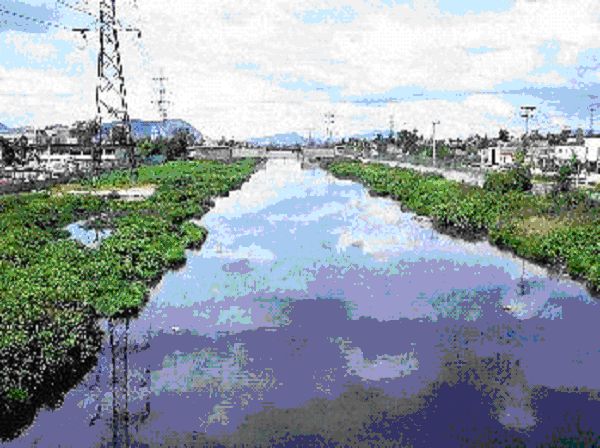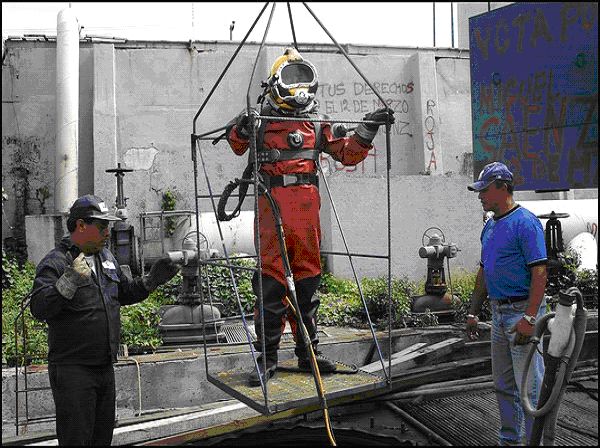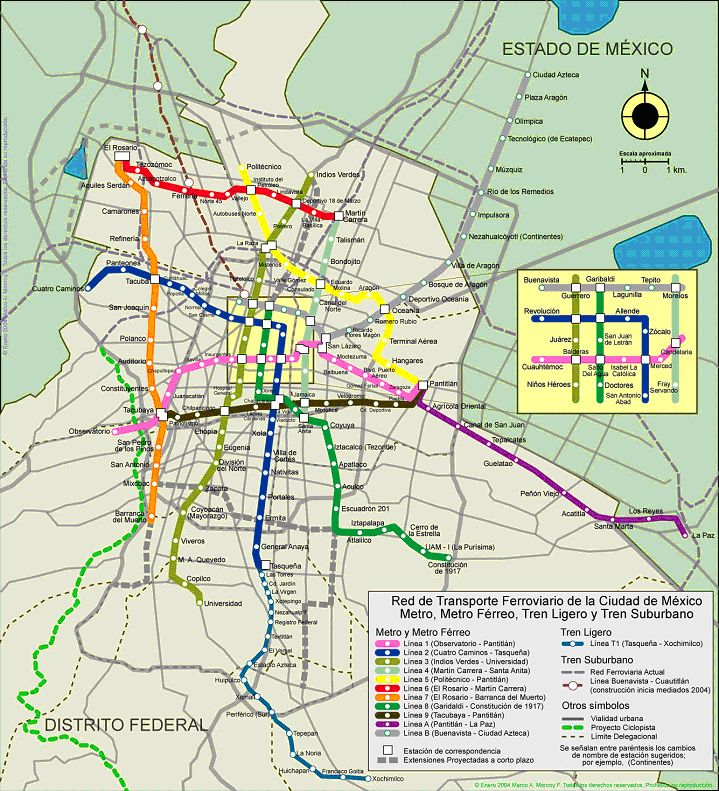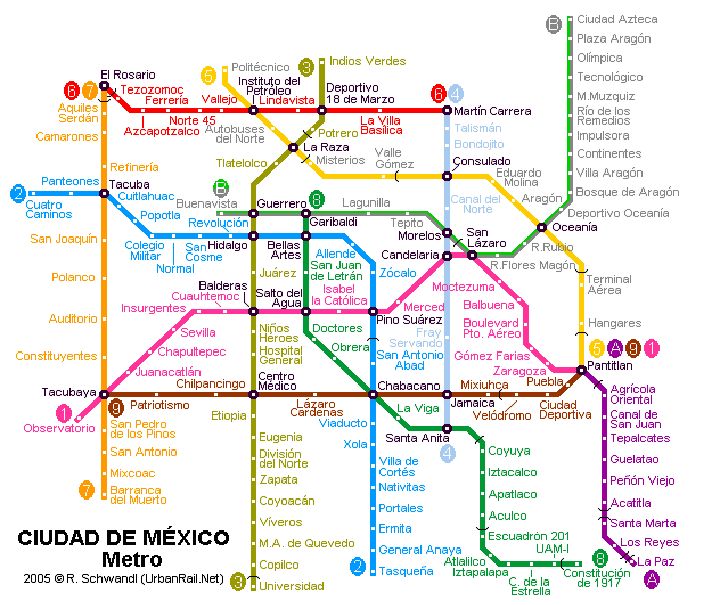The title of this symposium, “The Representation and Use of Urban Spaces,” inspires me to turn the phrase around and consider how useful urban spaces represent cities. In other words, I wonder if a comparative reading of the sewer and the metro might help us rethink a widely-held view of today’s Mexico City. For many, that city embodies two dichotomous yet uncomfortably coterminous worlds: on the one hand, a pre-modern, indigenous, informal, poverty-based squatter culture; and on the other hand, a hyper- or post-modern, multi-cultural, tele-connected, globalized or world city. Mexico City has grown exponentially in an extremely brief period of time relative to other cities in the developing world. In 1940, 1.6 million people lived in Mexico City. By 2000, 18.5 million people occupied 310 acres. Some figures today reach as high as 26 to 28 million. From 1950 to 1982, the city expanded by 36.5 square meters per day. In order to keep pace with that growth rate, the sewer system has been in continuous development, in a wide variety of forms, for centuries. Although the metro’s first line was not opened until 1969, the system has been growing ever since. Talking about the sewer evokes disgust, filth, stench, decay, refuse. The sewer contains all that we do not want to see or know about the city. We flush through the sewer all that we would like to forget about our materiality. Thus, the sewer is connected to the denigrated past. Talking about the metro, in contrast, evokes commerce, energy, access, and progress. The Mexico City metro represents national, centralized modernity; the wonders of city planning; and collective achievement in engineering. It is connected to an idealized future. But the sewer and the metro also have a lot in common. A consideration of the similarities as well as differences between the sewer and the metro, both urban systems of circulation, creates a more complex image of Mexico City. The sewer and the metro are both forms of public service without which the city could not survive today. The two systems inscribe urban space with so many detours, points of entry, and points of exit, that we might do well to let them lead us into a new way of conceptualizing the city as a socially signifying space. Identifying the simultaneous cultural histories that constitute the urban center, Nestor García Canclini names four cities that make up Mexico City: the historical-territorial city, the industrial city, the communicational city, and the city of multicultural hybridity. He speaks mostly of the Mexico City above ground, where people move about and believe they can see the city as it is. However, both the sewer and the metro, it seems to me, are key to the identity of each of those four cities in our contemporary urban imaginary. First, they literally unearth and flood the historical-territorial city. For example, excavation to build the Pino Suárez metro station in 1970 uncovered a circular pyramid dedicated to the Aztec god of the wind, Ehécatl. In the 21st century, backed-up pipes regularly flood new neighborhoods to the east of the city. Chalco is the most famous episode of that dynamic, where in the year 2000 heavy summer rains led to a flood of up to 2 meters of raw sewage in the poor community. A portion of the highway from Mexico City to Puebla was also flooded with the black sludge. As for the industrial city, the sewer and the metro both provide it with a continual supply of labor and a method for disposing of industrial waste with very little cost to any individual enterprise. Regarding the communicational city, the sewer and the metro literally communicate the many distinct barrios; their network form also represents the connectedness that sells Mexico City as global. Finally, the city of multicultural hybridity depends on the metro and the sewer to bring together both people and waste from diverse origins. Thus, the sewer and the metro channel both production and waste, evolving over time to accommodate the ever-expanding “mancha urbana.” In their ideal roles, the metro facilitates economic production by circulating workers and consumers throughout the city more efficiently and cleanly than any other form of transport can. And the sewer removes waste and water from the urban center so that the city can continue to offer open space for the circulation of people, goods, and capital on the surface. In addition, both of these systems traverse underground as well as above ground spaces. They both function as tubes, or piping systems, that direct continuous material flows. Fun Facts about the Sewer System The problem is geographical:
As the aquifer under Mexico City has been over-used in order to supply water to the city, ground level has sunk drastically. The rate has slowed in recent years due to control of the amount of water pumped from the aquifer, and now stands at about . 6centimeters/year:
The city still pumps water from the aquifer, but relies more heavily on water piped into the Mexico Basin from two catchments: the Lerma and Cutzamala basins, west of Mexico City, “which provide 6m3/s of groundwater and 13.5m3/s of surface waters respectively” (Morgan). The challenge is to keep rainwater from flooding “areas where the natural drainage has been reversed, and keeping wastewater from backflooding into artificially lowered areas” like the Chalco Basin. Water in Mexico City “passes through the citizens, animals, factories and sewage farms and passes out of the Mexico Basin to the Tula Basin to the north.” (Morgan). While wealthier cities sometimes have separate systems to drain rainwater and wastewater, Mexico City mixes the two, which causes sewage backups. Also, unregulated industrial and medical sources abuse the system:
As late as 1995, the Academia Nacional de Ingenieria was still calling for some “monitoring and protection program” to address the problem of contaminated ground-water. Their study, subtly titled “Mexico City's Water Supply Threatened By Overuse and Contamination,” highlights the “many factors that can contribute to ground-water contamination, such as hazardous waste control, treatment of industrial wastewaters, and proximity of unlined sewage canals to wells used for drinking water.” ([1995]) (1) Thus, access to potable water joins with sewage and rainwater drainage to form a single problem when subsidence (sinking) forces outflow from the Mexican Basin to travel against gravity. In 2001, Mayor Andres Manuel Lopez Obrador argued that the city should renovate the pumping system of the Grand Canal in order to flush wastewater from the city more effectively (Lindsay). At that time, the 120-miles of 15-foot wide undergound pipes was not sufficient to handle the city’s sewage and flooding problems. The new pump was to suck “more than 13 percent” of the city’s wastewater into the Grand Canal, which directs the flow of aguas negras into the neighboring State of Mexico. Engineers doubt that this initiative can work because, although Mexico City is sinking, the land to the north is not, “causing the Grand Canal to see-saw backward.” In addition, “[a] series of ‘black water’ canals drain sewage and chemical-contaminated water from the various parts of the city. About 7 percent of the water … is passed to 27 different treatment plants where it is treated, and this joins the remaining…untreated water to make its way into the Tula catchment and from there to the Gulf of Mexico” (Morgan). There are roughly 600 miles of sewers and drainage pipes of all sizes below Mexico City. Journalists happy to cover some of the strangest jobs on the planet have described the work of the four full-time sewer divers the city employs to swim around in the disgusting goo and clear away large debris.
Swimming in human waste and industrial chemicals, these divers clear pipes and repair pumps in an effort to keep the aguas negras flowing.…They have to do it completely by feel, because flashlights are useless in the murky goo. The divers remove large amounts of garbage. Plastic bottles predominate, but the sewer divers have found half a Volkswagen that they had to hack apart so that it could be lifted out in sections. They also routinely find furniture, trees, dead animals, and even human murder victims (Jordan). Fun facts about the Metro The total length of Mexico City subway is now well over 200 km. long. That does not include a light rail line serving the southern part of the city (18 stations, from Tasqueña to Embarcadero). There are currently 11 lines, all using rubber tires like some lines in Paris, Montreal and Santiago de Chile. It was the first metro system to use symbols and colors to identify the stations, an innovation introduced in relation to the 1968 Olympic Games in Mexico City, although the metro wasn’t running until 1969. The Mexico City metro is the cheapest subway system in the world, and it has one of the biggest transfer stations in the world: Pantitlán, terminus of lines 1, 5, 9, A. The new Master Plan for the Metro projects a total of 17 metro lines (13 urban and 4 suburban) along with 10 light-rail lines by the year 2020. (4)
How the lines intersect, how often along their trajectories, and in what neighborhoods of the city, is of great concern to metro riders because of how those intersections dictate their movement through the city.
The map we see here (Fig 4) is superimposed
over the surface terrain of the city, even though the actual train lines
cross over and under the ground level. In addition, the stylized version
of the metro map, the one you actually see on the walls when you are inside
the system, makes no visual reference at all to topography.
This map (Fig 5) represents the lines as much straighter and the links as much more compact than they really are in physical space. This way of drawing the system ironically makes it more navigable for passengers even as it distorts the reality of their passage through urban spaces. The number of journeys increases such distortion exponentially. Anywhere between 4 million and 5million people ride the metro each day. That is more than the city’s population when the metro was first designed. In a certain sense, these two-dimensional representations do capture the reality of the metro. They offer us an image of the containment of unruly space, a design that invites human beings to move into the system, as well as accessible and attractive iconography. Tourist advertising about Mexico City always highlights the efficiency of the metro, its marvelous resilience in the face of major earthquakes, and the planning acumen of city governors from the 1960s to the present in their ability to provide such a smooth and extensive transportation network. Contrast this promotion of the metro with the fact that
it’s very difficult to find representations of the sewer system. Perhaps
the problem of sewage is just too close to the real for comfort. Politicians
don’t get huge returns on their investment of time and political capital
for being photographed in front of sewage treatment plants, pumps, or reinforced
open sewage canals. New metro lines running to the suburbs, however, are
shiny, technological, and train the eye on the future rather than on the
unfortunate history of Mexico’s water and drainage problems. It’s easy, therefore,
to see the sewer as the underbelly of hyper-urbanization whereas the metro
is its celebrated modernist motor. This observation leads us to the concept of the abject in
psychoanalytic terms. In The Powers of Horror, Julia Kristeva bases
her work on Mary Douglas’s treatment of purity and the impure. Kristeva argues
that abjection is the nausea, the extreme physical reaction we have of repugnance
when faced with filth, excrement, bodily fluids, spoiled food, etc. She explains
this repugnance as the sign of our psychological need to establish a clear
difference between our idea of ourselves as whole, pure, self-contained,
clean and those pieces of material evidence that we excrete, we exude, we
ingest. In other words, we are permeable nodes in a system of flows, and
we hate it when we are confronted with that reality. It is not the case that
we are “above” while the abject is “below,” no matter how hard we try to
design our lives to make that appear to be true. The Mexico City sewer system,
failing because of geology, failing because of governmental and political
incompetence, failing because of demographic overload, confronts the city
itself with abjection. It periodically fails to maintain the illusion of
our separation from our own waste. It also infects the zones around the city
in extremely obvious ways. Periodic cholera outbreaks in Hidalgo, caused
by untreated sewage from the city, belie the notion that the urban center
is the seat of progress, where progress is understood in modernist terms
as improved social services, hygiene, or rationality in collective living.
The more the city tries to export its waste, the more evident it becomes
that its status as site of production and modernity is an illusion. By seeing
in the sewer an example of urban abjection, we alter the notion that it represents
the pre-modern of the city. In actuality, it provides the basis upon which
the modern city comes to be modern—precisely through its frustrated denial
of its own fluid nature. The desagües, when public spaces are
flooded with filth, manifest modernity’s dark side in the present. In this
reading, the sewer is the abject while the metro—the site of functional and
productive design—is allied with the Lacanian Symbolic. It works like a (is?)
a signifying network that relies on successful distinctions, order, regularity,
and clarity in order to bear meaning (passengers).
Making no distinction between Man and Nature, they refer here to bodies, food, sunlight, electrical current, water, sex, any form at all in which we might recognize the flow of energy that connects systems together. Foucault has described Deleuze and Guattari’s project as an intellectual and political one: a call to
Taking Deleuze and Guattari literally, I think of
the sewer and the metro as two particularly apt settings in which to consider
this notion of production as non-mediated flow. The metro stations, like
divergent sewer pipes, interrupt the flow of travelers or divert them, depending
on whether the people make line transfers or exit the system at any given
point. And yet the system as a whole keeps moving no matter at what nodes
any individual passenger enters or exits. The Mexico City sewer works the
same way, insofar as it collects rainwater and wastewater indiscriminately.
Equally indiscriminately, it blends the waste products of every type of residential
and industrial area of the city, making no concessions to race or class.
It channels some of that flow into treatment facilities, and some of it into
open canals of raw sewage. Some of those canals reach farmland in the north
to fertilize crops that will be transported back to the city and consumed.
Other canals lead straight into the Gulf of Mexico, thus connecting Mexico
City to the global environment in a far more material form than through its
much-touted (read, “clean”) electronic communications and banking networks.
Tracing the sewer and the metro through Mexico City leads in one sense to
a series of dichotomies: pre-modern/modern; past/future; waste /production;
the material/the ideal; the organic/the technological; the chaotic/the planned.
It also leads, however, to the deconstruction of just such dichotomies.
Monsiváis focuses not on the metro’s image of a well-oiled modern machine, but rather on its capacity to encompass everyone. This description of the metro’s fantastic victory over spatial limitations highlights the dissolution of boundaries between bodies. The metro brings us all together, blending sweat, stench, our very physicality, into an impossibly expansive national imaginary. Through this representation of the metro, Monsiváis disavows the difference between technology and corporality, the real city and the imagined nation. And we can apply that mode of representation to the sewer. It is the corporeality and abject of the past that we still think of as primitive, dirty, or uncivilized. But it is also an over-flowing present. Divers have to swim around in the sewer to keep its contents moving, while the metro miraculously keeps millions of people moving. The modern chemistry and engineering needed to understand and channel the city’s drainage system contrast with the cultural critic’s magical faith in the metro as an infinitely expanding space. What do these observations say about Mexico City itself?
It is not only a question of the pre-modern versus the modern in historical
terms. And it is not just a question of the Imaginary versus the Symbolic
in psychoanalytic terms. Both the sewer and the metro map the city as simultaneously
hyper-physical and fantastic. They do so through the radical uncontainability
of their multiple flows. That understanding helps me appreciate in an entirely
new way what I hear so many middle-class Mexicans say all the time: “Bueno,
pues, el metro es una mierda.”
NOTES 1 Academia Investigación Científica/Academia Nacional De Ingeniería/National Research CouncilCommission On Geosciences, Environment, And Resources Water Science And Technology Board 2 This “black water” canal is part of the extensive surface drainage which moves the sewage and chemical-contaminated water through Mexico City to the major pumping stations which discharge the water into the Tula Basin. The surface of the canal is constantly rippled by bubbles of methane gas which rise to the surface.” (Morgan). Photograph copyright Alan V. Morgan 3 (Note from the Editor: Permission has been requested for the publication of this photo of a diver. No word yet.) “Carlos Barrios Orta is one of the divers who maintain Mexico City 's 600-mile-long sewer system, clearing out debris so it won't back up into streets.” (Mary Jordan -- The Washington Post ) 4 All of this information is cited from Urban Rail. Net 5 From the website “Por un transporte moderno y eficiente para la Ciudad de México” REFERENCES Academia Nacional De Ingeniería/Academia Investigación Científica/National Research Council Commission On Geosciences, Environment, And Resources Water Science And Technology Board. Mexico City's Water Supply: Improving the Outlook for Sustainability. Washington, D.C.: National Academy Press, 1995. Deleuze, Gilles and Guattari, Félix. Anti-Oedipus: Capitalism and Schizophrenia. Minneapolis: University of Minnesota Press, 1983 [1972]. Dickerson, Marla. “Keeping a city's sewage on the move: Taming 'the monster': Floating in a sea of human waste and industrial chemicals, Mexico's sewer divers risk their lives to keep the 'black waters' flowing” Sunday Reader; Pg. D13 Copyright 2003 CanWest Interactive, a division of CanWest Global Communications Corp. Edmonton Journal (Alberta). April 27, 2003 Sunday Final Edition Douglas, Mary. Purity and Danger: an analysis of the concepts of pollution and taboo. London ; Boston : Ark Paperbacks, 1984, c1966 Foucault, Michel. Preface to Anti-Oedipus: Capitalism and Schizophrenia. Minneapolis: University of Minnesota Press, 1883 [1972]: xi-xiv. García Canclini, Nestor. “Las cuatro ciudades de México” Cultura y comunicación en la ciudad de México, Vol. I (Modernidad y multiculturalidad: la ciudad de México a fin de siglo). García Canclini et al., Editors. México: Grijalbo, 1998. -----. Imaginarios urbanos. Buenos Aires: Editorial Universitaria de Buenos Aires, 1997. Jordan, Mary. “Deep-Slime Divers Keep Vast and Smelly Sewers Flowing.” Washington Post Foreign Service. Monday, August 30, 2004; Page A18 <http://www.washingtonpost.com/wp-dyn/articles/A45322-2004Aug29.html> Kristeva, Julia. The Powers of Horror. An Essay on Abjection. New York: Columbia University Press, 1982 [1980]. Lindsay, Reed. “City looks to deal with waste water problem,” The News. August 21, 2001. Monroy, Marco. “History of the Mexico City Metro.” <http://www.urbanrail.net/am/mexi/mexico.htm> Monsiváis, Carlos. Los rituales del caos. Mexico, D. F.: Ediciones Era, 1995. Morgan, Alan V. “Mexico city: A Megacity with BIG Problems” (Alan V. Morgan, Department of Earth Sciences, University of Waterloo, Waterloo, Ontario, N2L 3G1). <http://www.science.uwaterloo.ca/earth/waton/mexico.html> |


 Fig 4
Fig 4  Fig
5
Fig
5